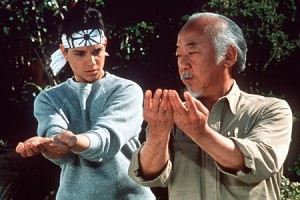My general pattern over the past 5 months has been to fight every 14 days, giving me 10 full days of training between matches. It’s a comfortable pattern and I like it. It’s enough time to work on particular details of my game and make decent progress and it’s also frequent enough that fighting itself becomes part of my training regimen. A fight is a pop-quiz of sorts to see how well I’m doing in the techniques and tactics that I’m training.
Twice now I’ve had two full weeks between fights. The extra time training is good, allowing me more flexibility in being able to get hurt in training and recover rather than just enough time to recover from the last fight before entering the next one. I’m not a fan of the two weeks though. It feels incredibly long, like I’ve actually taken time “off”, even though that’s not the case.
From my last fight to this one I worked a great deal on blocking kicks on the left side of my body (having trained prior to that to block on the right side as I was facing a southpaw) and to cover distance in the ring with quick, leaping back-foot strides instead of marching in incrementally. I got my kicks to come out as quick responses to attacks, impressing me and satisfying some of my trainers who were pretty baffled at my inability to do this already. My progress seemed steady and strong. Padwork with Andy made me feel really good in that I started responding with counter strikes as I was receiving strikes instead of having to pause before answering. My confidence in that regard was pretty high.
But then when the fight came around I didn’t do any of these things. If I’d stood in range (like I practiced) and just ate a kick in order to respond with my own, I would have outdone her. If I’d closed the distance with punches and followed with kicks, I would have outdone her. If I’d kept my hips in when I got in close she wouldn’t have been able to lock my neck and I would have outdone her. All those things I practiced, all those hours I spent trying to wear a new groove over the old grooves of habitual movements didn’t “take” enough to be present for this fight. My mind pretty much went blank or totally betrayed me; I could hear my corner and acknowledge what they wanted me to do, but by the time I got back to the corner at the end of the round it was like being reminded that I had just totally blanked on what they’d told me to do.
Here’s the thing. Even though it feels like an eternity between my last fight and this one, it was really only three weeks. I absolutely believe that you can change as a fighter in three weeks. I believe (and have witnessed in myself) that you can learn something in three days. But being able to apply that consistently under pressure is something else and in the grand perspective of what it takes to actually be the kind of fighter one wants to be, three weeks is nothing. And according to David Wong, it’s all “‘The Karate Kid’s’ fault.”
In his article “How ‘The Karate Kid’ Ruined the Modern World”, Wong argues that the montages in movies like “The Karate Kid” and basically every teen make-over movie ever that show
“Five breezy minutes, from sucking at karate to being great at karate, from morbid obesity to trim, from geeky girl to prom queen, from terrible garage band to awesome rock band,”
has resulted in the equivalent of sticker shock in American adults, only it’s “effort shock” – the cost of achievement is much higher than we’ve been led to believe. He goes on:
“In the real world, the winners of the All Valley Karate Championship in The Karate Kid would be the kids who had been at it since they were in elementary school. The kids who act like douchebags because their parents made them skip video games and days out with their friends and birthday parties so they could practice, practice, practice. And that’s just what it takes to get “pretty good” at it.”
He says “pretty good” here because in order to achieve mastery the time and effort requirement is, as described in Malcolm Gladwell’s book Outliers, somewhere around 10,000 hours of deliberate, concentrated effort (original study). That is, not a damn montage.
Damnit, Wong is right. I don’t blame “The Karate Kid” because it has no actual relevance to my life other than referential quotes here and there and the tendency for folks to compare Master K to Mr. Miyagi, but as a child born in the 80’s I have been absolutely inundated with the ubiquitous quick montage. But if you look at Kung Fu movies like “The 36th Chamber of Shaolin” or any classic Hong Kong movies of that ilk and you see an extended training sequence – or, more commonly, the majority of the movie is a series of training sequences with a final showdown at the end – not the two minute montage of Hollywood.
the youtube video I believe works
What happens is that my training at the camp becomes montage-ified in my brain so that I think I’ve hit these highlights of accomplishment without realizing that it’s only been three weeks. Or 10 days, in most cases. I’m working toward my 10,000 hours without question, but when I put it in perspective of the grand scheme of actually becoming a great fighter – not just snuffing the blonde jerks from the Cobra Kai team – the 5 months that I’ve been training and fighting in Thailand have been a period of immense growth. If I were to have the courage to sit down and actually watch the 12 fights I’ve had over that time, I’d be able to see the progress in montage form.
I need to remind myself that I’m not in the Hollywood picture, I’m in the Hong Kong edit. My movie is 90% training sequence and when I get to the final showdown it’s not going to be a total domination – it’s going to be messy and painful and the victory will come by a margin of technicality and a landslide of heart. Because that’s the way it’s supposed to be. When I first started putting my training videos online Master K wanted me to edit them to show only the quick, beautiful moments in 30 second highlight reels. He can do that kind of thing in one take because he’s amazing. But I wanted to show how I learn, which means showing mistakes and failure and overall that’s what my channel is. I’m a work-in-progress and sometimes progress is slow.
I love me some montage and ultimately I’ll be able to pick out the highlights of my growth as a fighter to stitch together something really spiffy. But my conviction is that my particular development as a fighter is like math class: show your work.



























